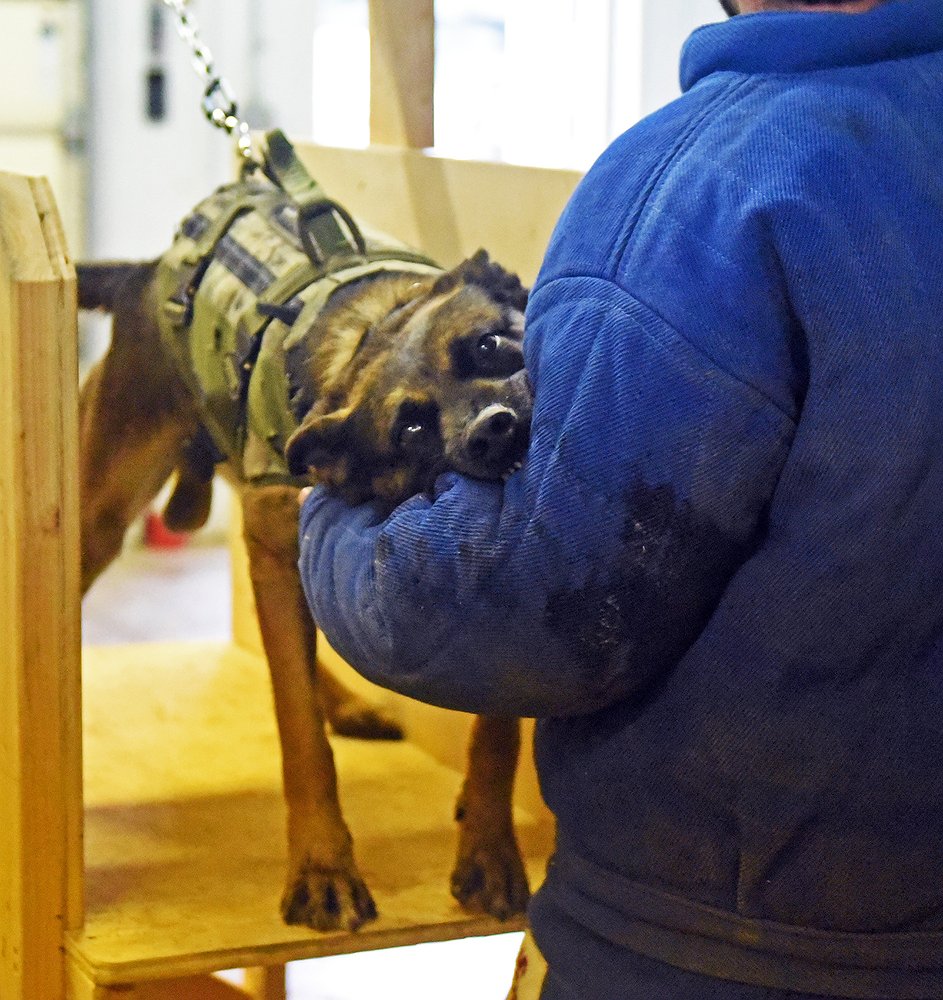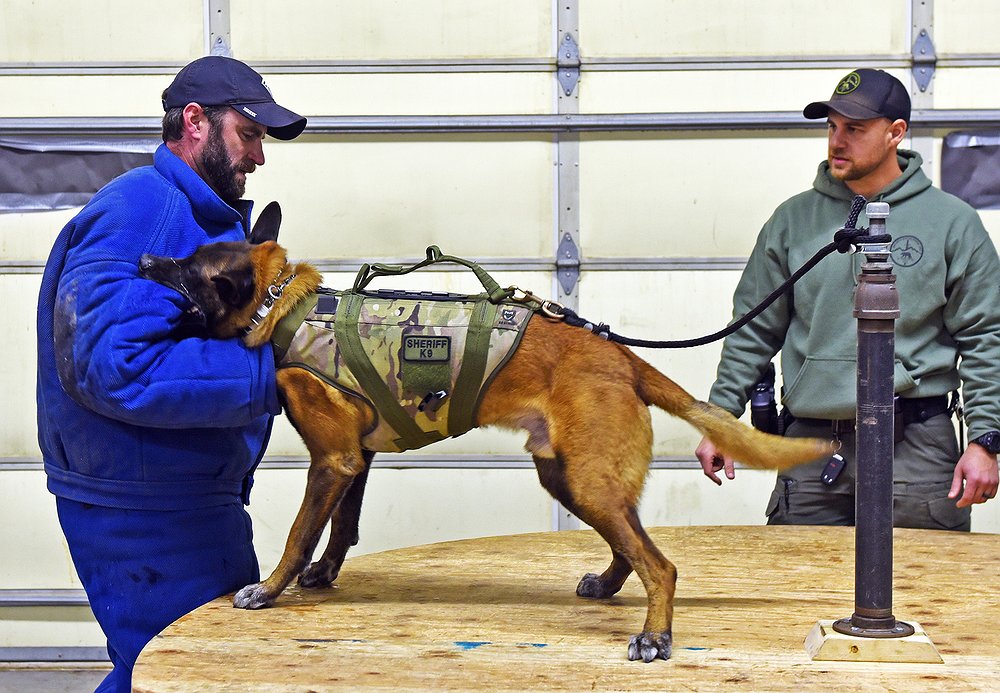Flathead County Sheriff's Office adding more K9 teams
Sounds of a prolonged, one-sided skirmish echoed in a large warehouse recently, where Flathead County Sheriff’s Office deputies were taking part in a selection process for a new K9 handler.
The agency currently has two apprehension, or patrol, K9 teams, and two detection teams, trained to find narcotics and explosives. Within the next few months, the Sheriff’s Office plans on adding more K9 teams.
Both of the agency’s active apprehension dogs came to the Northwest Montana Regional SWAT team with their handlers. Deputy Patrick McGauley and Audie came from Florida, and Deputy George Minaglia and Vito are from California.
This will be the first time a K9 team is developed locally. The goal is to add two K9 teams by the end of May.
“What we would like to see is 24-hour coverage of a K9 asset to our patrol officers,” said Sgt. Travis Smith of the Flathead County Sheriff’s Office. “The sheriff is very serious about how well this program has worked out and the number of people … and the types of people we have been able to detain using these resources.”
Recently, K9 officer Audie earned a medal for his part in the capture of a fleeing suspect from Idaho. Audie indicated that the suspect was hiding in a trailer which led to the apprehension of the man accused of carjacking, robbery and shooting at officers.
“He had committed multiple dangerous felonies in three different states. Audie found him and we were able to take him into arrest without incident,” Smith said. “[The K9 officers are] an incredible resource.”
In October, a Kalispell man allegedly led law enforcement officers on a chase that ended after he nearly struck a deputy with his vehicle and tried to choke the K9 officer, Audie. The suspect was charged with attempted deliberate homicide and criminal endangerment.
Audie has since recovered and has been training at full speed.
“That’s why we do training, to subject these dogs to stuff they might encounter on the street and let them work through that,” said McGauley.
Each month, the K9 teams on the Northwest Regional Montana SWAT team log about 30 hours of training and Mignalia said there are a lot of unpaid hours that go into maintaining an effective K9 team.
“To get a team up and running is about $30,000. Between the cost of the dog, putting the handler through school, equipment and, assuming we already have a car that just needs to be outfitted with a cage, that’s what it comes to,” Mignalia said. “Just the dog and the school is around $20,000.”
Smith agrees that a K9 team is expensive, but said calling two dozen men out for a SWAT call is expensive, too, and that the dogs pay dividends in the end.
He said there must be extensive training so the dogs are prepared for a variety of environments and so their partners are legally, morally and ethically responsible for how the dogs are used.
“It's one of those tools that is invaluable as far as being able to preserve human life and being able to do our job as effectively and as safely as possible,” said Smith. “Knowing somebody is inside a building … and is a danger to us before we are there is invaluable.”
LAST MONTH, Flathead County Sheriff’s Office deputies were involved in a selection process to become the next K9 handler.
The full day of testing involved scenarios, problem solving, policies and procedures. Candidates also worked directly with the K9 officers. The training gave Smith and other evaluators a chance to see how the men react to the dogs and to the training.
“A big part of being a K9 partner is being able to decoy for your partner so he can work his dog,” Smith said.
Being a decoy requires the deputy to don a protective suit and play the part of the bad guy. In order to train the dogs, the decoy must be fully committed to responding appropriately to the dog’s actions so the exercise is constructive.
During the training, the dog bites the decoy’s upper arm and holds him still. When the man tries to move away, the dog readjusts his bite, clamping down more effectively each time.
Throughout the nearly ten-minute exchange, there is a mix of eye contact and no eye contact. Occasionally, the decoy will reach for the dog’s paws, flank, and head, so the dog can practice his responses.
Sparse commands to the dogs are given calmly, in a mix of Dutch and German. The experienced handlers also give instruction and feedback to the deputies vying for the new handler position throughout the training session.
The dogs require very little direction but McGauley and Minaglia consistently offer encouragement to their canine partners, with, “Yes,” “Good boy” and even an occasional, sing-songy “Good job, buddy.”
Likewise, the men support the decoy after the session.
“You tired or something?” a fellow deputy said in jest, knowing the training is exhausting and is an activity Smith described as trying to move a hard, heavy weight while wearing a hot, bulky suit.
When the decoy removed the protective suit, red marks and bruises on his upper arm were evidence of the strength of the dogs’ jaws.
“That dog can bite, huh?” a nearby deputy says, with a nod to the damaged arm.
ONCE THE HANDLER is selected, he and the master trainers will choose the right dog for the handler and for the department. Smith says it is quite the process but it is very important the dog is a good fit for the community.
“One of the things that is very difficult about what we do in this process, is making sure that we find the right dog,” Smith said. “Sociability is a big factor for us. We want that dog to be able to turn that (drive) on and off.”
For instance, Audie meets the public and is a big hit with children when he visits local schools. Yet, McGauley said of his partner, “as soon as it’s game time, he’s all business.”
The next FCSO canine will be a dual-purpose dog, trained in both patrol and explosives detection. It requires more training but it gives the community “more bang for your buck,” as Smith said.
Even though they are apprehension dogs and their training involves bite and hold maneuvers, Smith said it is not all about apprehensions and called the dogs a life-saving tool.
“Just the presence of the dog has resulted in an outstanding number of surrenders, where they’re just a de-escalation tool,” Minaglia said. “They cause that person to give up. It keeps everybody safe and that’s the ultimate goal.”
Smith noted that having K9 team coverage around the clock will provide a new level of safety for officers and for the community.












